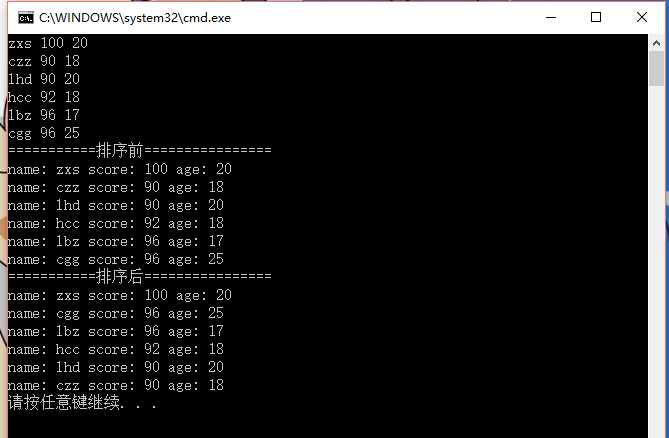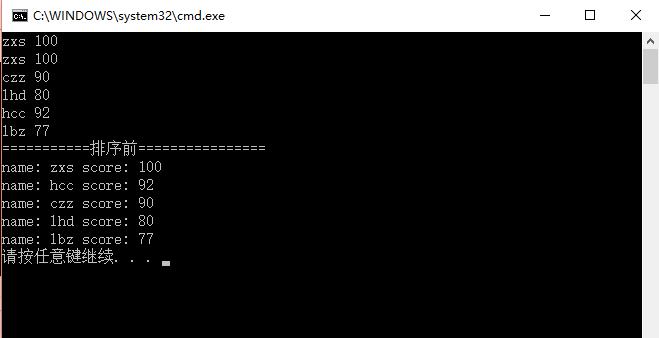关于C++中vector和set使用sort方法进行排序
Posted 周晓松的博客
tags:
篇首语:本文由小常识网(cha138.com)小编为大家整理,主要介绍了关于C++中vector和set使用sort方法进行排序相关的知识,希望对你有一定的参考价值。
C++中vector和set都是非常方便的容器,
sort方法是algorithm头文件里的一个标准函数,能进行高效的排序,默认是按元素从小到大排序
将sort方法用到vector和set中能实现多种符合自己需求的排序
首先sort方法可以对静态的数组进行排序
1 #include<iostream> 2 using namespace std; 3 int main(){ 4 int a[10] = { 9, 0, 1, 2, 3, 7, 4, 5, 100, 10 }; 5 sort(a, a +10); 6 for (int i = 0; i < 10; i++) 7 cout << a[i] << endl; 8 return 0; 9 }
运行结果:

这里可以看到是sort(a,a+10),但是数组a一共只有9个元素,为什么是a+10而不是a+9呢?
因为sort方法实际上最后一位地址对应的数是不取的,
而且vector,set,map这些容器的end()取出来的值实际上并不是最后一个值,而end的前一个才是最后一个值!
需要用prev(xxx.end()),才能取出容器中最后一个元素。
对vector使用sort函数:
第一种情形:基本类型,如vector<int>,vector<double>,vector<string>也是可以的
1 #include<iostream> 2 #include<vector> 3 #include<algorithm> 4 using namespace std; 5 int main(){ 6 vector<int> a; 7 int n = 5; 8 while (n--){ 9 int score; 10 cin >> score; 11 a.push_back(score); 12 } 13 //cout <<" a.end()"<< *a.end() << endl; 执行这句话会报错! 14 cout << " prev(a.end)" << *prev(a.end()) << endl; 15 sort(a.begin(), a.end()); 16 for (vector<int>::iterator it = a.begin(); it != a.end(); it++){ 17 cout << *it << endl; 18 } 19 return 0; 20 }
执行结果:

看到了吗,实际上end的前一个指针指向的元素才是插入时的最后一个值!
排序后从小大大。
第二种情形:用自定义的结构体进行sort算法,
这时候需要自己定义个比较函数,因为sort算法是基于容器中的元素是可以两两比较的,然后从小到大排序,所以要自定义怎么样才是小于(\'<\')
1 #include<iostream> 2 #include<vector> 3 #include<set> 4 #include<string> 5 #include<algorithm> 6 using namespace std; 7 struct student{ 8 char name[10]; 9 int score; 10 }; 11 //自定义“小于” 12 bool comp(const student &a, const student &b){ 13 return a.score < b.score; 14 } 15 int main(){ 16 vector<student> vectorStudents; 17 int n = 5; 18 while (n--){ 19 student oneStudent; 20 string name; 21 int score; 22 cin >> name >> score; 23 strcpy(oneStudent.name, name.c_str()); 24 oneStudent.score = score; 25 vectorStudents.push_back(oneStudent); 26 } 27 cout << "===========排序前================" << endl; 28 for (vector<student>::iterator it = vectorStudents.begin(); it != vectorStudents.end(); it++){ 29 cout << "name: " << it->name << " score: " << it->score << endl; 30 } 31 sort(vectorStudents.begin(),vectorStudents.end(),comp); 32 cout << "===========排序后================" << endl; 33 for (vector<student>::iterator it = vectorStudents.begin(); it != vectorStudents.end(); it++){ 34 cout << "name: " << it->name << " score: " << it->score << endl; 35 } 36 return 0; 37 }
运行结果:

不过有时候一个排序条件不够,比如要求学生按分数从高到低排序,如果分数相同,则按照年龄从大到小排序
就需要在comp自定义函数里面修改一下判断了,原来是直接return a.score < b.score
现在就需要判断
if (a.score > b.score)
return true;
else if (a.score == b.score && a.age > b.age)
return true;
else
return false;
这里一定要记得else return false!!!有一次比赛的时候写到这个函数,有三个判断条件,结果忘了这茬,总是报错,
到后来有点着急了就自己手动实现了一下写了三个比较函数,调用了三次sort函数!!!!!
1 #include<iostream> 2 #include<vector> 3 #include<set> 4 #include<string> 5 #include<algorithm> 6 using namespace std; 7 struct student{ 8 char name[10]; 9 int score; 10 int age; 11 }; 12 //自定义“小于” 13 bool comp(const student &a, const student &b){ 14 if (a.score > b.score) 15 return true; 16 else if (a.score == b.score && a.age > b.age) 17 return true; 18 else ///这里的else return false非常重要!!!!! 19 return false; 20 } 21 int main(){ 22 vector<student> vectorStudents; 23 /*set<student> setStudents;*/ 24 //int n = 5; 25 int n = 6; 26 while (n--){ 27 student oneStudent; 28 string name; 29 int score; 30 int age; 31 cin >> name >> score>>age; 32 strcpy(oneStudent.name, name.c_str()); 33 oneStudent.score = score; 34 oneStudent.age = age; 35 vectorStudents.push_back(oneStudent); 36 } 37 cout << "===========排序前================" << endl; 38 for (vector<student>::iterator it = vectorStudents.begin(); it != vectorStudents.end(); it++){ 39 cout << "name: " << it->name << " score: " << it->score << " age: "<<it->age<<endl; 40 } 41 sort(vectorStudents.begin(), vectorStudents.end(), comp); 42 //sort(setStudents.begin(), setStudents.end()); 43 cout << "===========排序后================" << endl; 44 for (vector<student>::iterator it = vectorStudents.begin(); it != vectorStudents.end(); it++){ 45 cout << "name: " << it->name << " score: " << it->score << " age: " << it->age << endl; 46 } 47 return 0; 48 }
运行结果如下:

接下来,对于set做类似的操作。
set是一个集合,内部的元素不会重复,同时它会自动进行排序,也是从小到大
而且set的insert方法没有insert(a,cmp)这种重载,所以如果要把结构体插入set中,我们就要重载\'<\'运算符。
set方法在插入的时候也是从小到大的,那么我们重载一下<运算符让它从大到小排序
1 #include<iostream> 2 #include<vector> 3 #include<set> 4 #include<string> 5 #include<algorithm> 6 using namespace std; 7 struct student{ 8 char name[10]; 9 int score; 10 }; 11 //自定义“小于” 12 bool comp(const student &a, const student &b){ 13 return a.score < b.score; 14 } 15 bool operator < (const student & stu1,const student &stu2){ 16 return stu1.score > stu2.score; 17 } 18 int main(){ 19 //vector<student> vectorStudents; 20 set<student> setStudents; 21 //int n = 5; 22 int n = 6; 23 while (n--){ 24 student oneStudent; 25 string name; 26 int score; 27 cin >> name >> score; 28 strcpy(oneStudent.name, name.c_str()); 29 oneStudent.score = score; 30 setStudents.insert(oneStudent); 31 } 32 cout << "===========排序前================" << endl; 33 for (set<student>::iterator it = setStudents.begin(); it != setStudents.end(); it++){ 34 cout << "name: " << it->name << " score: " << it->score << endl; 35 } 36 //sort(setStudents.begin(), setStudents.end(), comp); 37 //cout << "===========排序后================" << endl; 38 //for (set<student>::iterator it = setStudents.begin(); it != setStudents.end(); it++){ 39 // cout << "name: " << it->name << " score: " << it->score << endl; 40 //} 41 return 0; 42 }
运行结果:

我们可以看到,set内元素不会重复,而且它按照它所认为的“从小到大”进行了排序
以上是关于关于C++中vector和set使用sort方法进行排序的主要内容,如果未能解决你的问题,请参考以下文章